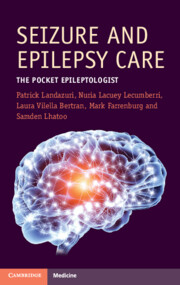Book contents
- Seizure and Epilepsy Care
- Seizure and Epilepsy Care
- Copyright page
- Contents
- 1 How Do I Evaluate a First-Time Seizure?
- 2 How Do I Make an Epilepsy Diagnosis?
- 3 Which Antiseizure Medicines Treat Epilepsy and How Do I Pick?
- 4 How Can I Best Use EEG for Treating Epilepsy Patients?
- 5 What Are Common Epilepsy Imaging Findings in New Onset and Chronic Epilepsy Care?
- 6 How Do I Care for Patients in the Emergency Department and Inpatient Settings?
- 7 How Do I Manage Epilepsy Emergencies Like Status Epilepticus?
- 8 What Is the Best Long-Term Treatment Plan for Epilepsy Patients as an Outpatient?
- 9 What to Do When Your Patient Fails Two Antiseizure Medicines
- 10 Nonepileptic Events and General Psychiatric Care for Epilepsy Patients
- 11 What Are Essential Pediatric Epilepsy Clinical Diagnoses and Treatment Plans?
- Index
- References
2 - How Do I Make an Epilepsy Diagnosis?
Published online by Cambridge University Press: 28 January 2023
- Seizure and Epilepsy Care
- Seizure and Epilepsy Care
- Copyright page
- Contents
- 1 How Do I Evaluate a First-Time Seizure?
- 2 How Do I Make an Epilepsy Diagnosis?
- 3 Which Antiseizure Medicines Treat Epilepsy and How Do I Pick?
- 4 How Can I Best Use EEG for Treating Epilepsy Patients?
- 5 What Are Common Epilepsy Imaging Findings in New Onset and Chronic Epilepsy Care?
- 6 How Do I Care for Patients in the Emergency Department and Inpatient Settings?
- 7 How Do I Manage Epilepsy Emergencies Like Status Epilepticus?
- 8 What Is the Best Long-Term Treatment Plan for Epilepsy Patients as an Outpatient?
- 9 What to Do When Your Patient Fails Two Antiseizure Medicines
- 10 Nonepileptic Events and General Psychiatric Care for Epilepsy Patients
- 11 What Are Essential Pediatric Epilepsy Clinical Diagnoses and Treatment Plans?
- Index
- References
Summary
A seizure is defined as abnormally coordinated electrical activity that is clinically noted as abnormal sensations, movements, or behaviors. Epilepsy is defined as the tendency to have seizures, practically as two unprovoked seizures at least 24 hours apart or one seizure with a 60% chance of additional seizures. The two overall epilepsy types are generalized and focal. Focal epilepsy most commonly indicates a focal brain injury like traumatic brain injury or tumor. In contrast, generalized epilepsy is due to a genetic etiology, not necessarily inherited. An epilepsy diagnosis is clinically made and can be supported by typical EEG and MRI findings. Nearly 4% of people develop epilepsy, with the largest peak during later years and the second peak during childhood. Nearly 70% of people are seizure-free after five years, whether via control with medications or, less commonly, the epilepsy itself remits. Life expectancy for epilepsy patients is lower. A key contributor to epilepsy mortality is sudden unexpected death in epilepsy (SUDEP). Uncontrolled generalized tonic clonic seizures are a key risk factor for SUDEP.
- Type
- Chapter
- Information
- Seizure and Epilepsy CareThe Pocket Epileptologist, pp. 23 - 40Publisher: Cambridge University PressPrint publication year: 2023

